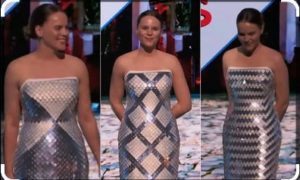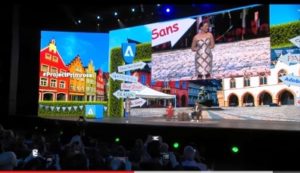By Tracy Yekaghe
Adobe has introduced an innovative “digital dress” through its “Project Primrose,” which enables wearers to instantly modify patterns on its surface with a simple button press using generative AI. This dress is constructed using sequins that incorporate “reflective light-diffuser modules” utilizing liquid crystals similar to those found in smart lighting systems.
RELATED: Virtual fashion try-on company launches tool to set up AI shopping experience for retailers




According to researchers, the sequins can be essentially characterized as minuscule screens constructed using advanced smart materials. This dress made its debut at Adobe’s MAX conference last week, where the software company portrayed it as a breakthrough in animating “fabric.” Video footage from the conference featured Adobe researcher Christine Dierk donning the strapless attire, which initially resembled a conventional cocktail dress. However, upon the activation of a remote control, the patterns on the dress underwent immediate and dynamic transformation.
Watch on Youtube.
“Unlike traditional clothing, which is static, Primrose allows me to refresh my look in a moment,” the Adobe scientist said while demonstrating that its colors can go from light to dark in a moment.
The researcher, who transitioned into a model, also demonstrated that the dress exhibited dynamic alterations, featuring animated designs where patterns seamlessly transitioned, alternating between states of opacity and transparency.
Christine Dierk, who played a dual role in both the dress’s design and manual assembly, demonstrated its responsiveness to motion.
Creatives are always looking for new canvases to play with she and fashion has always been a place where consumers and designers alike can express their creativity. She explained further that many fashion designers also made use of Adobe tools for their design process stressing that iterating illustrations can be easy and trying out a simple design can be as easy as clicking a button.
According to researchers, the dress is fabricated using “reflective-backed polymer-dispersed liquid crystal (PDLC),” a material commonly employed in smart windows. In a study presented at a technological conference last year, scientists noted that this low-power, non-emissive material is adaptable for various shapes and has the capability to dynamically disperse light. However, the dress’s potential weight-bearing capacity remains undisclosed.
Adobe pointed out that designers have the opportunity to integrate this technology into diverse applications, including clothing, furniture, and other surfaces, thereby unlocking a realm of limitless stylistic possibilities. This includes the ability to conveniently download and don the latest designs from favored designers.
The advanced sequins, integral to the high-tech component of Project Primrose, have found application in smaller product offerings, such as a handbag and a canvas.
Reacting to this latest innovation on one of her LinkedIn posts; Samantha Taylor who is the founder of the Good Factory, a sports wear company shared that: “Adobe are still trying to claw back their reputation with fashion after some rather lacklustre offerings since the launch of Adobe Creative Suite. They’ve been loosing out in 3D to gaming companies and start ups who are building with users in mind. While Adobe sit around and hope they have enough reputation to help carry them forward.
“Today we have a grey sequin dress that provides no wearable value. I bet those sequins aren’t recyclable.”
In similar vein David Francis Effiong also took to his LinkedIn profile to ask what he described as user-centric questions despite initially sharing about the advantages of the digital dress. He insisted to get further clarity as regards
– What happens when your Adobe license expires?
– Will people have to skip ads displayed on their dress(es)?
– How is laundry done? Or is the dress water and dirt – resistant too?
– Are there any wave exposure we should be aware of?
Adobe Inc., formerly Adobe Systems Incorporated, is an American multinational computer software company incorporated in Delaware and headquartered in San Jose, California.































